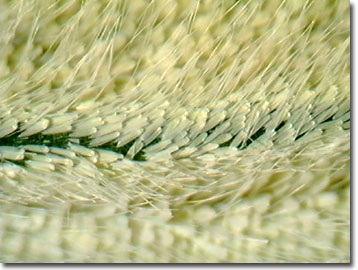Butterfly Wing Scale Digital Image Gallery
Lemon Yellow Giant Orange Tip Butterfly
Male lemon yellow giant orange tip butterflies feature strong serrations on the leading edge of their forewings, which may be important in male-male interactions and for defense. Indeed, life for the males of this tropical species is a contact sport. The butterflies can often be seen in small flocks swirling around each other or at mud holes in tight groups where jostling frequently occurs.

Scientifically described as Anteos menippe, the lemon yellow giant orange tip butterfly is one of the largest and most robust species in the butterfly family Pieridae. Built for long flights, the brightly colored butterflies are occasionally observed migrating in large flocks in Central and South America. Although collected widely throughout the American tropical rainforests, the butterflies are most common in Peru and Brazil, especially in urban and suburban areas where cassia, their preferred host plants, are used as landscaping along residential streets. For sipping nectar, the butterflies prefer to visit red and purple flowers, such as hibiscus, lantana, bougainvillea, and passionflowers.
The common name of the lemon yellow giant orange tip species is aptly descriptive of its more noticeable mode of appearance. The upper sides of its wings exhibit the beautiful coloration described in its name, as well as a pair of black false eyespots. However, the crafty species can exhibit another look when desired. If its wings are held upright with the undersides exposed, the butterfly looks like a green, veined leaf with a distinct midrib. The cryptic coloring acts as a safeguard against potential predators that may not be able to differentiate the camouflaged prey from surrounding foliage.
Lemon yellow giant orange tip caterpillars also display cryptic coloration. The larvae primarily feed on the leaves of cassia plants but, unlike many butterfly larvae that defend themselves with sequestered phytochemicals, remain palatable despite high concentrations of alkaloids in the cassia leaves. Therefore, instead of exhibiting a warning coloration, the caterpillars, which co-evolved with cassia plants, developed a different mode of protection. The caterpillars exhibit different cryptic color morphs depending on the time of the year and the location of the eggs on the host plant.
Contributing Authors
Cynthia D. Kelly, Shannon H. Neaves, Laurence D. Zuckerman, and Michael W. Davidson - National High Magnetic Field Laboratory, 1800 East Paul Dirac Dr., The Florida State University, Tallahassee, Florida, 32310.
BACK TO THE BUTTERFLY WING SCALE IMAGE GALLERY
BACK TO THE DIGITAL IMAGE GALLERIES
Questions or comments? Send us an email.
© 1995-2025 by Michael W. Davidson and The Florida State University. All Rights Reserved. No images, graphics, software, scripts, or applets may be reproduced or used in any manner without permission from the copyright holders. Use of this website means you agree to all of the Legal Terms and Conditions set forth by the owners.
This website is maintained by our
Graphics & Web Programming Team
in collaboration with Optical Microscopy at the
National High Magnetic Field Laboratory.
Last Modification Friday, Nov 13, 2015 at 01:19 PM
Access Count Since January 21, 2003: 8822
Visit the website of our partner in introductory microscopy education:
|
|
